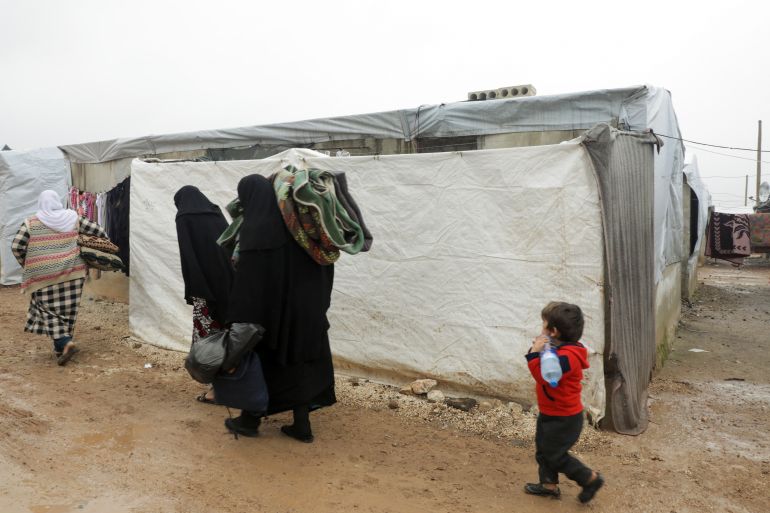This festive season, many displaced women are struggling
With inadequate aid, women-headed households in Syria, Afghanistan and Ukraine will find it hard to keep their children fed and warm.

This winter will be tougher than any most of us have known in our life time. Record high inflation, and skyrocketing fuel and food prices have led to protests and strikes across the world. Many families are facing difficult decisions on how to spend their dwindling incomes. But for households headed by displaced women, this winter will be even harsher.
About 34 million people are displaced by the conflicts in Syria, Afghanistan and Ukraine. A significant number of them live in households headed by women.
Keep reading
list of 4 itemsThe hostility Syrian refugees contend with in Lebanon
How Gaza’s children are preparing for Israel’s invasion of Rafah I Close Up
UK police arrest three over deaths of five people in English Channel
And these families truly struggle. Many live in tents that can easily collapse in heavy rain or snow. Income for them is hard to come by, as women struggle to get jobs amid high unemployment rates. It becomes even more difficult to find employment opportunities during the winter.
When they do find jobs, mothers face difficult choices about leaving their children alone and often have to deal with discrimination, harassment and prejudice. Pay could be as low as $1.50 per day and often does not cover expenses for food.
This winter, the situation is even worse because of quickly rising inflation in conflict areas, which is hitting the displaced the hardest. In Syria, for example, the price of basic foods has jumped by 800 percent in just two years.
Displaced people are also struggling to find warmth over the winter after fuel for heating has become unaffordable. This is especially the case for women-headed households, which often have to resort to burning waste to warm up their tents or cook.
This exposes the whole family to dangerous gases that could kill. The World Health Organization has estimated that 3.2 million people died in 2020 as a result of indoor pollution generated by such harmful practices; 237,000 were children under the age of five.
Indoor pollution also increases the risk of deaths from influenza, pneumonia and asthma and contributes to malnutrition.
While exact numbers of how many displaced people die as a result of waste-burning for heating are not available, we do know that such incidents are regularly reported at camps for the displaced and women-headed households are especially vulnerable.
As women struggle to keep their children fed and warm, they often fall into debt. This leaves them more exposed to violence and sexual exploitation and often forces them to engage in prostitution or give up their children to forced marriages or bonded labour. In Afghanistan, for example, girls are sold into marriage for $2,200.
Women-headed households also often find it difficult to keep children in school. They sometimes cannot attend because they do not have shoes or coats to make the journey to school.
Everything becomes that more challenging when the days are shorter in the winter and darkness brings heightened risk of abuse, harassment and kidnapping. With people crammed into single rooms to keep warm with little opportunity to go outside, tensions and domestic violence increase. The already restricted freedom of movement becomes even more unbearable. Unsurprisingly, mental health deteriorates during the winter.
Studies show that poor mental health of mothers is directly linked to long-term poor development indicators for children. Women we interviewed as part of World Vision research on the effect of winter on displaced communities said they had subjected their children to violence out of stress and frustration with their situation.
For humanitarian agencies, the difficult conditions displaced people face in the winter are nothing new and planning starts as early as July: from distribution of coats, shoes, heaters, to provision of fuel, flood prevention and management, repairs of shelters, to medical care and psychological support.
In Afghanistan, for example, everything must be in place by end of October ahead of the first snowstorms and it is the end of March before roads are open for trucks to pass again. But for all the planning, there are certain developments humanitarian agencies cannot predict: missile strikes on power plants, severe weather, an upsurge in fighting, global supply chain disruptions or, as is so often the case, lack of funds. As of the end of November, for example, the winterisation programmes of all humanitarian organisations operating in Syria were just 11 percent funded.
This year, many aid agencies have been stretched thin as the war in Ukraine has displaced millions more people. Many of them are members of women-headed households as men have been drafted into the army or joined as volunteers. Displaced Ukrainian women face a tough winter struggling to find stable shelter with few or no employment opportunities. Most are fully reliant on humanitarian aid and the support of host families who themselves are struggling with increased costs.
For the rest of the world, these conflicts seem far away and of no direct concern. But what the COVID-19 pandemic has taught us is that everything is connected. The world is like a giant game of Jenga. Every time a piece is removed in one place, it effects the stability of the whole structure. Whether it is fuel and food prices, the surge in migration, the costs of conflict or climate change, everything is connected and has an effect on our lives.
So even as we all contemplate a tough winter with hard choices to make this festive season, we should put ourselves for a minute in the tent of a displaced family headed by a woman deciding who gets to eat tonight.
The views expressed in this article are the author’s own and do not necessarily reflect Al Jazeera’s editorial stance.
